- Books Name
- A TEXT OF BIOLOGY - CLASS XII
- Publication
- ACME SMART PUBLICATION
- Course
- CBSE Class 12
- Subject
- Biology
POPULATIONS
(i) Deme: Local population (population living in a specific area).
(ii) Metapopulation : Whole set of local populations connected by dispersing individuals.
(iii) For the purpose of ecological studies, a group of individuals resulting from asexual reproduction is also considered as population.
Population attributes / group attributes
Some characters are unique to the group and are not characteristic of the individuals forming it, like an organism born and dies, and has age, but it does not have a birth rate, death rate and age ratio.
These population characters can be best expressed by statistical methods, some important characters are:
1. Population Density
The number of individuals per unit area, like millions of Spirogyra filaments in a pond, or 200 plants of Parthenium in an area.
This can also be expressed as "The population biomass per unit area or volume" when we have to count a large number of organisms (like grasses) or to find out the role of a single huge banyan tree in an area.
Relative density is a good measure of finding out the total density of fishes in a lake by counting the number of fishes caught per trap.

 Tiger census in India is based upon pug marks and fecal pellets which indirectly estimates population size.
Tiger census in India is based upon pug marks and fecal pellets which indirectly estimates population size.
2. Age Ratio Pyramids
Age Pyramlds : An age pyramid is a graphic representation of proportion of various age groups of a population. There are three types of age pyramids -triangular, bell-shaped and urn-shaped.
(a) Triangular : It is graphic representation of a young or growing population and has a very high proportion of pre-reproductive individuals.
(b) Bell-Shaped: The pyramid is bell-like with pre-reproductive individuals being only marginally more than the reproductive individuals. Population is said to be mature or stable.
(c) Urn-Shaped : It has small number of pre-reproductive individuals followed by a large number of reproductive individuals. Such a population shows negative growth.

3. Population Growth
Some attributes of population are used to estimate its growth, as population size may fluctuate in a given habitat during a given period due to change in four basic processes, namely
(i) Natality: Birth rate, inherent ability of a population to increase and refers to number of births during a given period in the population that are added to initial density.
The per individual change in a population due to natality can be estimated by using ![]()

Where, Nn = New individuals produced
N = Initial population
t = Change in time
(ii) Mortality: Death rate, number of individuals dying in a population in a given period.
(iii) Immigration : One way permanent inward movement of the individuals of same species into a habitat with existing population. This may help to speed up the growth or prevents extinction of a smaller population. In plants, it is equivalent to settlement of disseminules.
(iv) Emigration : One way permanent outward movement of number of individuals from a population to other habitat area, hence reducing the size of local population. Plants are fixed, so do not show emigration.
By these population characters the density of a population (N) at time t can be expressed after a period of time t + 1 as
N(t + 1) = Nt + [(B + I) -(D + E)]
Where; B = Number of birth, I = Number of immigrants, D = Number of deaths and
E = Number of emigrants
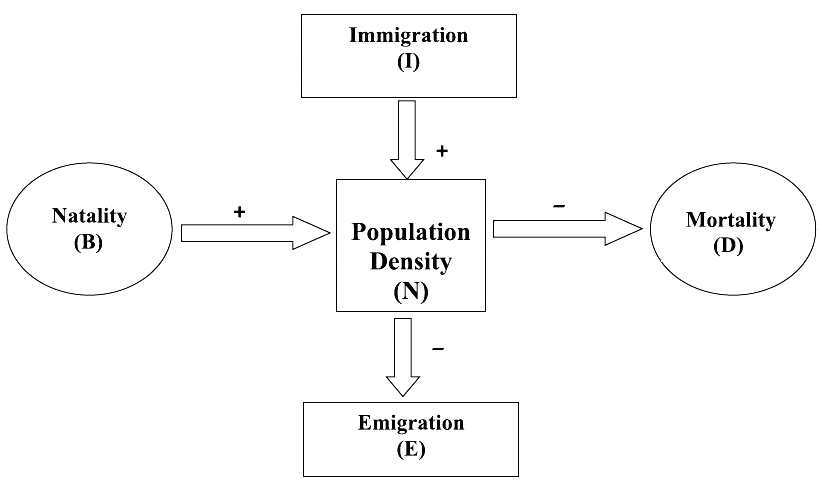
So, it can be concluded that births and deaths are most important factors influencing population density and other two are specialised cases.
4. Growth Models
Biotic Potential and Environmental Resistance: Biotic potential is the maximum or potential natality.
The sum of environmental factors that limits the population size is called environmental resistance.
Environmental resistance rises with the rise in population size.
The influence of environmental resistance over the biotic potential is denoted by (K-N/K).
Carrying Capacity (K) : The maximum number of individuals of a population which can be supported with optimum resources for their survival is called carrying capacity of the environment.
Growth of a population depends upon its biotic potential, death rate and birth rate. Depending upon the amplitude of these three, a population may show :
(a) Exponential growth, and (b) Logistic growth
(a) Exponential growth :
Darwin believed the geometric growth of a population when the resources are unlimited, as each species realises its inherent power to grow.
This intrinsic rate of natural increase is called r.
The value of r is an important parameter to assess impact of environmental factors on population growth.
(i) Any increase or decrease in a population N during time t will be dN/dt = (b - d) × N, where (b = per capita birth rate) and d = per capita death rate. If (b - d) = r, then dN/dt = rN
(ii) The integral form of exponential growth equation will be Nt = N0ert where; Nt = Population density after time t, N0 = population density at time zero, e = the base of natural logarithms (2.71828).
(iii) The magnitude of r was 0.0205 in 1981 for human population in India while it reached 0.0176 in 2001. For Norway rat it is 0.015 and for flour beetles it is 0.12.
(iv) Equation dN/dt = rN describes geometric growth resulting in a J-shape curve. Such population stops abruptly due to environmental resistance, which becomes effective suddenly, or a resource may become depleted. Decline in J-shape population is density triggered e.g., Algal blooms, insect population.
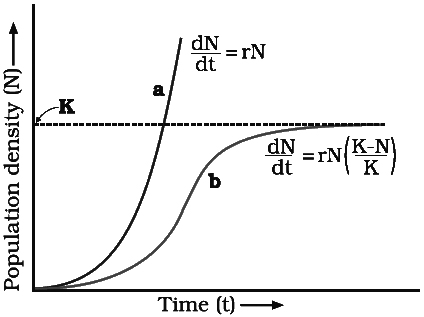
(b) Logistic Growth
This growth form is characterised by function of carrying capacity (K) for a given population, giving it a more realistic form.
Such forms are represented under limited resource conditions where a population finally reaches an asymptote.
This growth form can be described as Verhulst Pearl Logistic Growth and is expressed as  .
.
Since resources for growth for most animal populations are finite and become limiting sooner or later, this plot is more realistic.
Life History Variation : Populations evolve to maximise their reproductive fitness in a given habitat. It includes variation in life history, evolved in relation to the selection pressure imposed by environmental factors in order to achieve the most efficient reproductive strategy.
Some of the strategies are listed below:
(i) Small number of large sized individuals are produced (mammals and birds).
(ii) Larger number of small sized individuals are produced (Oysters and pelagic fishes).
(iii) Some organisms breed once in life time (Bambusa and Pacific salmon fish).
(iv) Some organisms breed many times during their life (mammals and many birds).
5. Population Interactions
The interactions between members of different populations are based upon 3 factors:
(i) Requirement and mode of obtaining food.
(ii) Nature of shelter or space required.
(iii) Habits of the species like aggregation, breeding etc.
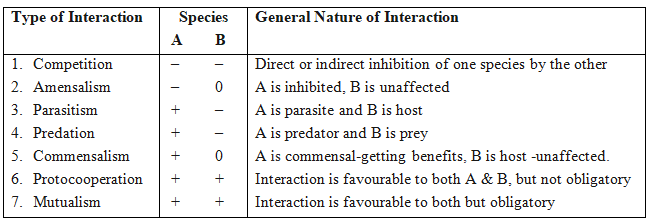
Different population interactions (+, -, 0 for beneficial,
detrimental and neutral respectively).
The various important types of interactions between members of biotic community are described below:
A. Competition
It is a process in which the fitness of one species (measured in terms of its 'r' the intrinsic rate of increase) is significantly lower in the presence of another species.
It is the struggle between two or more organisms for obtaining various requirements for their survival.
It is both intraspecific, i.e., between organisms of the same species and interspecific, i.e., between organisms of different species.
Intraspecific competition is more acute because all organisms of the same species have similar requirements for food, space, light, water, shelter, mate etc.
The interspecific competition occurs when organisms of different species belong to same trophic level or have similar feeding habit e.g., in grassland, severe competition occurs between herbivores like rabbits, deer, bisons etc., as all feed upon grass.
Competition for zoopalnktons between visiting flamingoes and resident fishes in South American lakes.
It may be emphasized that competition is noticed only when required commodity is in short supply.
If grass is in plenty and fulfill the needs of all herbivores of that area, there will be no competition or only little, if at all it occurs.
Carnivorous animals like tigers and leopards compete for the common prey.
In forest, shrubs, herbs and trees compete with one another for water, inorganic nutrients, sunlight and for insects that bring about pollination and for animals that bring about dispersal.
In competition superiority of individual (intraspecific) or superiority of species (interspecific) plays an important role.
No two species can occupy the same ecological niche and live together in a biotic community, this can be further understood by Gause's competitive exclusion principle (1934).
Gause found that if two species of Paramecium namely P caudatum and P aurelia, were grown together in same culture medium, initially both increase in number, but eventually P caudatum population declines and is eliminated by superior species P aurelia.
This shows that if two species are occupying same ecological niche and competing for common resources, then superior type will exclude or eliminate the inferior type of species.
There are some circumstancial evidences which supports exclusion of species due to competition e.g.,
(i) Introduction of goats resulted in exclusion of Abingdon tortoise from Galapagos islands.
(ii) Same interaction occurs between Balanus and Chathamalus on rocky coasts of Scotland (Connell, 1961).
Coexistence :
Species facing competition might evolve mechanism to live in the same niche by changing the feeding time or foraging patterns, i.e., resource partitioning.
If different species coexist inspite of being competitors, it is because they are specialised or adapted differently (different feeding habits) to obtain same resources.
That is why Darwin found that fourteen species of finches coexist in Galapagos islands due to development of different feeding habits.
Several plants grow together by sending roots to various depths.
More examples are cited below to explain coexistence aspect of competition.
(i) Five closely related species of warblers avoid competition by changing foraging pattern (MacArthur).
(ii) "Tribolium-Trifolium" model is best to explain both exclusion and coexistence.
(iii) Habitat diversification can also reduce competition e.g., Tribolium and Oryzaephilum (Crombic, 1947).
Competitive release: There occurs a dramatical increase in population of a less distributed species in a geographical area when its superior competitor is removed experimentally from that area.
Plant and herbivores are more affected than carnivores.
Resource need not to be limiting for competition to occur as feeding efficiency of one species might be reduced due to inhibitory presence of other species. This is called "interference competition".
B. Predation
It is a type of interaction in which the members of one species capture, kill and eat up members of other species.
The species that captures is called predator and the other that is captured is called prey.
Most of the animals except the scavengers (animals eating the dead animals only) are predators.
Even certain plants (e.g., Nepenthes, Utricularia, Dionaea, Drosera) are predators, catching and digesting insects in addition to their autotrophic mode of nutrition.
They are called insectivorous or carnivorous plants.
Prey-predator relationship, like competition, is an interaction of ecological importance.
Prey-predator relationship is utilized by man in biological control of pests.
Opuntia was weeded out in Australia with the help of its natural herbivore called Cactoblastis (Cochineal insect).
Red locust menace was brought under control in Mauritius by Mynah.
Mosquito larvae are eaten by larvicidal fish such as Gambusia (top minnow).
In the rocky intertidal communities of the American pacific coast the starfish Pisaster is an important predator.
Role of predation :
(a) Transfer of energy (in ecological sense herbivores are not very different from predators).
(b) Keeping prey population under control.
(c) Rabbit population in Australia increased tremendously because the land does not have its natural predators. Red faxes in Newzealand became top carnivores due to absence of a natural top carnivore.
(d) Predators help to maintain species diversity in a community as they can reduce the intensity of competition among prey species e.g., Experimental removal of Pisaster (star fish) resulted in extinction of more than 10 species of invertebrates in American Pacific coast.
(e) Term prudent predator (Slobodkin, 1962) explains that predator does not exterminate its prey by overexploitation.
For their defence, prey species have evolved various adaptations, viz
(i) Camouflage e.g., Insects, frogs

(ii) Monarch butterfly is well known for its general unpalatability to its predator birds. This insect is able to sequester the highly toxic glycosides present in milkweeds on which its caterpillar stages feed (Brower et.a/., 1968). There larvae develop on milkweed, providing the protection to plant against herbivory.
(iii) Highly poisonous cardiac glycosides are produced by Calotropis and nicotine, caffeine, quinine, strychnine, opium are other means of chemical defence in plants.
(iv) Association of bull horn Acacia cornigera with Pseudomyrmex ferrugenea (ant) is also against herbivory.
Association of Acacia -Pseudomyrmex and Monarch butterfly -milkweed are examples of coevolution also.
C. Parasitism
It is a relationship between two organisms of different species usually differing in size in which one organism spends a part or whole of its life, on or in the body of other organisms and gets nourishment and shelter from that.
The former organism is termed parasite and the latter as host.
This also depresses the growth rate of host population or may reduce the total size of host population.
Parasites are smaller generally, majority of them are host specific.
High reproductive potential, loss of digestive system and unnecessary sense organs, presence of specific sucking or adhesive organs are some of their characters, but they have poor means of dispersal.
D. Mutualism
It is an obligate association of two organisms in which each derives benefit from the other.
In mutualism, two organisms often live together and can't live separately, the two organisms may be plants, animals or one plant and other animal.
(i) Mutualism between plant and plant e.g., lichen (Alga and Fungus), mycorrhiza (Fungus and roots of higher plants), Rhizobium (N2-fixing bacteria in root nodules of legumes).
(ii) Mutualism between plant and animal e.g. , Green algae Chlorella vulgaris (endosymbiont) in gastrodermal cells of Hydra. Plant pollinator relation sometimes is a one-to-one coevolutionary relation like fig and wasp relation, Ophrys and Colpa relation, Yucca and Pronuba relation.
(iii) Mutualism between animal and animal e.g., Protozoan Trichonympha in gut of termites. Protozoan helps in cellulose digestion and in return gets shelter.
E. Protocooperation
It is a non-obligatory interaction between two organisms of different species, in which both are mutually beneficial to each other, but can easily live separately.
Two birds, namely red-billed ox pecker and yellow-billed ox pecker feed on ticks and other parasites sticking to the skin of black rhinoceros and relieve him of the parasites.
The birds sitting on Rhinoceros for feeding on ticks, etc., also warn the animal of approaching danger.
The birds are not only benefitting the animal, but themselves are benefitted too as the animal is providing food (ticks, etc.) to the birds.
This is an example of protocooperation as the birds have no close association with animal, it just visits him occasionally for feeding.
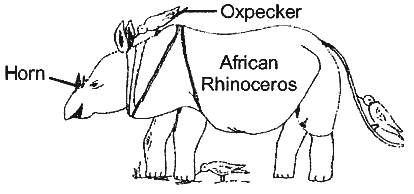
Another example of protocooperation is the relationship between plover bird and the crocodile.
The bird enters the open mouth of the crocodile, feeding on the leeches which are attached to the lining of buccal cavity.
The bird not only is getting benefit from the animal (getting food) but helps the animal in getting rid of leeches which are sucking its blood.
The association between sea-anemone and hermit crab may also be taken as an example of protoco-operation in which sea-anemone is attached to snail's shell.
Sea-anemone is sedentary and can move from one place to another using snail's shell as portable home and is able to procure more food.
The hermit crab is protected from its enemies by the sea-anemone having nematocysts.
F. Commensalism
It is an interaction between two organisms of different species, benefitting only one species, the other species is neither benefitted nor harmed.
The species which is benefitted is termed commensal and the other species is called host.
Examples of commensalism are observed in diverse types of animals and even in plants.
(i) The pilot fish (Remora) always accompanies shark with a purpose of feeding upon small pieces of food falling off when shark is tearing its prey. The fish is not attached to shark at any time.
(ii) Sucker fish is attached to underside of shark, getting a free ride and occasionally detaching itself when the latter is feed upon small pieces of food.
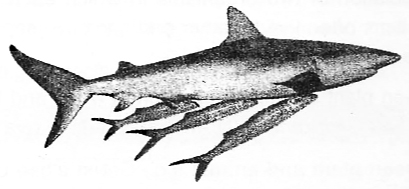
(iii) Jackals and arctic foxes follow lions and seals, respectively for feeding upon left out food pieces by the predators.
(iv) Barnacles (Balanus) live attached to whale's body, not getting any benefit from it except shelter.
(v) Epiphytes are attached to other plants but not getting anything from the host. They are green, thus nutritionally independent and have special hygroscopic roots which can absorb water present in the atmosphere in the form of vapours. They get shelter only from the host. They are able to get proper sunlight too for photosynthesis by growing on higher branches of trees in thick forests.
(vi) Cattle egrets (birds) forage close to where cattles are grazing because the cattles as they move, stir up and flush out from the vegetation insects that otherwise might be difficult for the egrets to find and catch.
(vii) Sea anemone has stinging tentacles that protect clown fish living among them.
G. Amensalism
It is an interaction between two organisms of different species in which one species inhibits the growth of other species by secreting certain chemicals.
This phenomenon of inhibition of growth of one species by the other species through secretion of certain chemicals is also termed allelopathy (in plants), or antibiosis or biological antagonism.
Examples of amensalism are evident in micro-organisms.
Penicillium secretes penicillin, that inhibits the growth of large number of bacteria. Similarly, different species of Streptomyces, an actinomycete, produce wide range of chemicals which inhibit the growth of other bacteria, some of which cause various diseases in human beings.
Such chemicals isolated from these microorganisms are thus, used as antibiotics for curing various diseases caused by bacteria.
Inhibition of growth of one species by organism of other species is observed in higher plants as well.
Roots of black walnut (Juglans nigra), secrete a chemical juglone which is toxic to other plants like apple, alfalfa, etc. Convolvulus arvensis inhibits the growth of wheat.

 ACME SMART PUBLICATION
ACME SMART PUBLICATION
